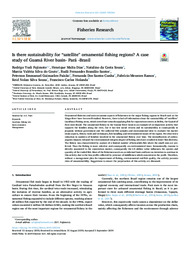Is there sustainability for satellite ornamental fishing regions? A case study of Guamá River basin, Pará, Brasil.
Is there sustainability for satellite ornamental fishing regions? A case study of Guamá River basin, Pará, Brasil.
Summary: Ornamental fisheries and socio-economic aspects of fishermen in the major fishing regions in Brazil such as the Xingu River have been well studied. However, there is lack of information about the sustainability of ?satellites? (auxiliary) fishing areas, which contribute towards supplying fish for exportation centers as Belém, the Capital of Pará state-Brazil. The ornamental fishery in the Guamá River basin is an example of an important activity that supports the families along the river, but it has low social returns and its sustainability is consequently in jeopardy without government aid. We collected fish samples and environmental data to evaluate the market chain aspects, fishery tools and techniques, fish handling and environmental issues of the region. We observed a reduction in numbers of families involved in the ornamental fishery over time. The intensification of anthro- pogenic impacts reduced the environmental integrity degree of fishing sites have resulted in lower fish diversity. The fishery was characterized by capture of a limited number of loricariids fish where the small ones are pre- ferred. Thus the fishing is more selective and consequently an environmental issue. Economically, income is directly associated to the exportation market, consequently the US dollars value influences the species and quantity of the traded fish. Most of the fishermen work on an informal basis and have no intention to continue in this activity due to the low profits reflected by presence of middlemen which concentrates the profit. Therefore, without a management plan for improvement of fishing, environmental and fish quality, the activity presents risks of unsustainability. Suggestions to ensure the perpetuation of this activity are discussed.
Publication year: 2020
Types of publication: Journal article
Keywords: Peixe, Peixe Ornamental, Pesca, Pesca ornamental
Observation
Some of Embrapa's publications are published as ePub files. To read them, use or download one of the following free software options to your computer or mobile device. Android: Google Play Books; IOS: iBooks; Windows and Linux: Calibre.
Access other publications
Access the Agricultural Research Database (BDPA) to consult Embrapa's full library collection and records.
Visit Embrapa Bookstore to purchase books and other publications sold by Embrapa.

